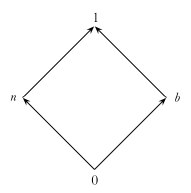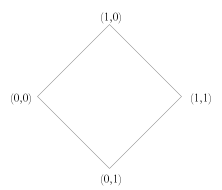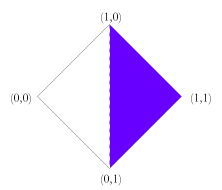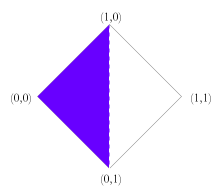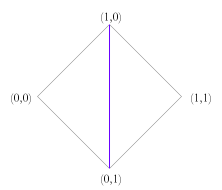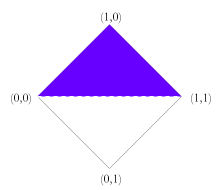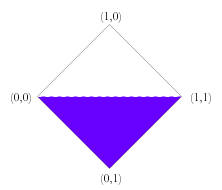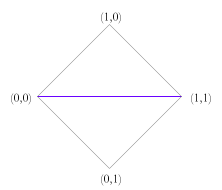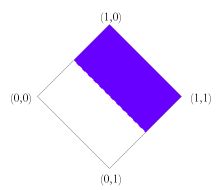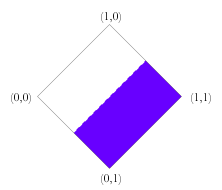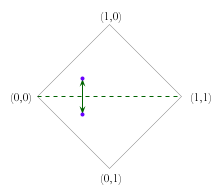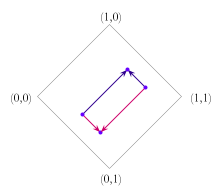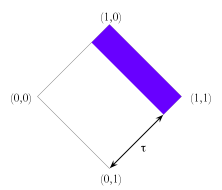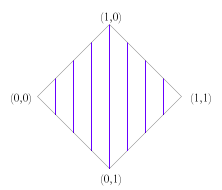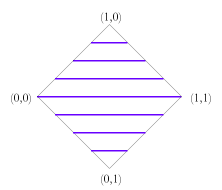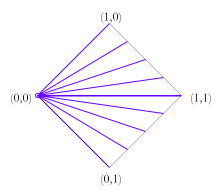
| Degrees of Truth, Degrees of
Falsity Toby Ord In this paper I recall the reasons in favour of extending the classical conception of truth to include degrees of truth as well as truth value gaps and gluts, then provide a sketch of a new system of logic that provides all of these simultaneously. Despite its power, the resulting system is quite simple, combining degrees of truth and degrees of falsity to provide a very flexible and elegant conception of truth value. One way to extend classical logic is to add new truth values. In classical logic, we have but two: True and False. Sentences are thus either absolutely true or absolutely false. Fuzzy Logic People have argued that this dichotomy is not warranted. For example, consider sentences of the from, 'x is bald'. For some values of x (i.e. for some people), this sentence is clearly true. For others it is clearly false. However, there doesn't seem to be any precise line between being bald and not being bald. For some people it does not seem to be completely true to say that they are bald or to say that they are not bald. Depending on one's conception of baldness, this troublesome band might be thick or it might be quite thin, but it certainly seems to exist. One way to understand this situation is to claim that there are degrees of truth. These are typically represented by the real numbers in the interval [0,1]. The extreme points (0 and 1) represent absolute falsity and absolute truth, while the values in between represent intermediate truth degrees. We can then say that the truth value of 'Michael is bald' is 1 (it is absolutely true), the truth value of 'John is bald' is 0 (it is absolutely false) and the truth value of 'Paul is bald' is 0.3. Or perhaps it is 0.4. We do not need to be able to say precisely, but merely to insist that there is some answer. When a system of logic uses degrees of truth it is called fuzzy logic. Such systems typically define the logical operations as follows:
Such systems thus allow us to assess sentences involving one or more vague properties, such as warm, old, strong, fit, happy, bright and so forth. This is potentially of considerable philosophical use in tackling vagueness and the related sorites paradox (although it is by no means a panacea). Fuzzy logic also has more practical uses, having made a considerable impact in engineering within the domain of control systems. It is often convenient to program a series of logical conditions and corresponding actions into a machine, and fuzzy logic allows the values of the propositions involved to come directly from the machine's sensors (such as thermometers or motion detectors). Fuzzy logic can then allow the machine's effectors (such as the temperature of the machine's heating element) to vary continuously as its inputs change, avoiding the discrete jumps that would occur using classical logic. Of course such behaviour could be directly programmed into the machines, but allowing the behaviour to be governed by a system of logic has additional benefits such as ease of design and the potential to prove results about its operation. Truth Value Gaps The restrictiveness of the truth values in classical logic is also challenged on another front. Suppose that you have a radioactive atom and want to know the truth value of the sentence 'The atom will decay within the next half-life'. On the most common interpretation of quantum mechanics, this sentence does not seem to have a determinate truth value before the experiment is performed: it would appear to be neither true nor false. This state is sometimes referred to as a truth value gap. One might even think that this occurs in less exotic statements about the future such as 'It will rain in Melbourne on the first day of Autumn in 2077'. Furthermore, one might think that sentences which suffer reference failure are neither true nor false. For example, 'The greatest prime number is not even' or 'Sherlock Holmes is wise'. The same might be said about sentences that suffer from category mistakes, such as 'The capital of Ireland is 3', or that are ungrammatical, such as 'Runs capital violet the.' These sentences make different kinds of mistakes and the best way to understand some of these might be to say that the sentences are meaningless, or otherwise flawed, in such a way as to prevent them from being true or false. Alternatively, if you subscribe to an understanding of truth which equates it with verifiability, then you might also run into truth value gaps. This would occur when there is a sentence P such that neither P nor ¬P can be verified. None of these arguments are definitive, but there is at least a case for introducing a new truth value for sentences that are neither true nor false. Let us use the symbol 'n' for this truth value and continue to use '1' and '0' for True and False respectively. We could then use the following tables to define how the familiar logical connectives operate on these values:
These tables seem to capture the relationships
involved and thus allow us to form and evaluate complex sentences
built up of statements that may be neither true nor false.
We can then define logical inference by saying
that 1 and b are designated while n and 0 are
not. Thus valid arguments are those that cannot take us from premises
valued 1 or b to conclusions valued n or 0. This
system has received considerable study and is a very natural generalisation
of the two kinds of three valued logic.
As can be seen, this set of truth values takes us beyond those present in fuzzy logic and four valued logic, but the extension is very natural. The definitions of the logical operations also come very naturally, combining the methods of fuzzy and four valued logics.
Note that when restricted to classical values, these connectives give the classical results; when restricted to 0, n, b, 1 they give the four valued logic results; and when restricted to the well-defined values, they give the fuzzy logic results. As with fuzzy logic, we can designate those values where the degree of truth is greater than or equal to the value of a parameter, τ. As with the three and four valued logics, n is never designated while b is always designated. Other under-defined or over-defined values may also be designated, depending on their degree of truth. As per the three and four valued logics, the falsity of the value is irrelevant when it comes to considering designation — only the degree of truth matters. We can again define validity simpliciter as validity for all values of τ.
On reflection, we can see a variety of potentially important properties of these new truth values, such as definedness, net truth and proportional truth:
Note that there are also subsets of this space of truth values which are of considerable independent interest, and for which the rules above can be easily adapted. For example, there is the triangle formed by removing the over-defined values. This leads to a natural unification of the truth value gap based three valued logics with fuzzy logic. There is also the corresponding triangle formed by removing the under-defined values which leads to a unification of fuzzy logic with the truth value glut based three valued logics. One could also consider the union of the well-defined values (those of fuzzy logic) with the points (0,0) and (1,1). This would give a minimal unification of four valued logic with fuzzy logic. In this case the conjunction and disjunction rules would have to be modified so to take account of the missing intermediate values. It is not obvious how best to do this. Just as there are versions of fuzzy logic which have finitely many truth values between 0 and 1, so we could do this in the present system. One merely needs to posit a matching degree of falsity for every degree of truth. Similarly, we could restrict degrees of truth and falsity to rational values. Obviously these modifications could be combined with the ones above. Further Work This paper is just a bare sketch of a theory of degrees of truth and degrees of falsity, and there is much more work that could be done on the topic. For one thing, it is worth noting that I have brushed over the use of conditionals in logics with more than two truth values. There are two standard ways to construct the conditional in three valued logics and at least two ways for fuzzy logic. I have not spent much time considering the natural ways to do so in the unified system as I have little intuition on the matter. Presumably there are at least two natural ways to do this, which would each form their own logic. Developing these would no doubt be an interesting project. Similarly, I have not constructed a proof system and thus have no soundness or completeness results. I don't imagine that this would be too difficult and encourage others to do so. Finally, and perhaps most importantly, I have not provided any example domains where such truth values would naturally arise. I feel that there are probably examples both philosophical and practical, but have no 'killer applications'. On the practical side, there may be applications where rules conflict (tempting us to move to a paraconsistent logic to avoid the calamitous ex falso quodlibet) and where these rules involve vague properties. I can envisage such fuzzy conflicts occurring both in legal systems and in engineering control situations. On the philosophical side, there may well be paradoxes which combine vagueness and self reference, where the ability to provide independent degrees of truth and falsity provides a way out. Whilst this space of truth values is clearly of independent interest, it could certainly benefit from some highly motivating examples. References Graham Priest, An Introduction to Non-Classical Logic, (Cambridge: CUP), 2001. Note: — Since the writing of this piece I have become aware of a book which seems to include a theory of degrees of truth and falsity that is not unlike my own. I have not been able to examine this book, but from what I can tell, its truth values only include those whose definedness is less than or equal to 1. If so, it is a theory that unifies fuzzy truth with truth-value gaps, but does not address truth values which are over-defined. This book is: Atanassov K., Intuitionistic Fuzzy Sets, (Heidelburg: Springer-Verlag), 1999. |


